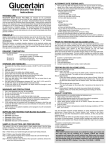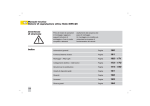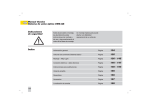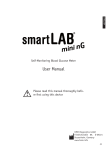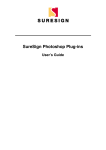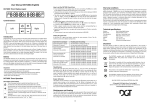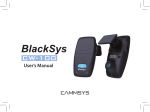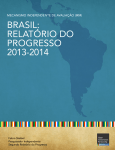Download - Suresign Diabetes
Transcript
SAMPLE COLLECTION AND PREPARATION Instructions Suresign Resure Blood Glucose Test Strips INTENDED USE The Suresign Resure SMBG System is intended for the quantitative measurement of glucose in venous whole blood or fresh capillary whole blood samples drawn from the fingertips, palm or forearm. Testing is done outside the body. (In Vitro diagnostic use). It is indicated for self-testing by persons with diabetes, or in clinical settings by healthcare providers, as an aid to monitor the effectiveness of diabetes control. The system is not to be used on neonates, is not for the diagnosis of or screening for diabetes mellitus, and that alternate site testing can only be used during steady-state blood glucose conditions. IMPORTANT Please read this insert and the Suresign Resure User’s Manual before using Suresign Resure Blood Glucose Test Strips. If you have any questions and/or need assistance, please contact our authorized distributors in your country. PRINCIPLE1, 2 Apply a blood sample to the blood collection area at the tip of the strip. The test strip will draw the blood sample into the reaction zone. The FAD-binding glucose dehydrogenase catalyzes the glucose dehydrogenation. It will produce gluconolactone. During the reaction, a mediator transfers electrons to the electrode surface and generates a current. The amount of the current is proportional to the amount of glucose present in the blood sample. After 5 seconds, the Suresign Resure meter will show glucose concentration on the screen. REAGENT COMPOSITION Each test strip contains the following reagent: 6 (w/w) % FAD glucose dehydrogenase (Aspergillus sp., 2.0 IU/test strip) 56 (w/w) % Potassium ferricyanide 38 (w/w) % Non-reactive ingredients STORAGE AND HANDLING 1. Store the test strip package in a cool, dry place, between 2°C~30°C (36°F - 86°F). Do Not freeze. 2. Keep out of direct sunlight and heat. 3. Write the date on the bottle when first opened. 4. Discard test strips 6 months after first opening date. 5. Replace the cap quickly after taking the test strip from the bottle. 6. Handle the test strip only with dry and clean hands. 7. Store your test strips in their original bottle only. Do not move them to any other bottle or container. WARNINGS AND PRECAUTIONS 1. 2. 3. 4. 5. For in vitro diagnostic use only. Do not swallow. Do not use the test strip after the expiration date. Do not re-use test strips. Do not cut, bend, scratch, or alter the test strip in any way. Warning for potential biohazard3: This warning is for the healthcare providers who use this system on multiple patients. They should know the product comes in contact with human blood. After cleaning, dispose of the product properly as if avoid transmitting viral disease. 6. If the readings are not consistent to your symptoms, check the manual first. Make sure you have followed all instructions, and then contact your doctor. 7. Never make any changes to your diabetes control program without consulting your doctor. 8. The system should be used at a temperature between 10°C and 40°C (50°F and 104°F). Outside this range, the system may get incorrect results. IMPORTANT If the control solution test results are outside the range, your meter and test strip may not be working as a system. Follow the correct procedures and repeat the control solution test. Make sure the control solution is clean without contamination. (e.g. Turbid.) Do not use the meter until test results fall within the appropriate range. If the problem continues, please contact your health professional. SUPPLIES FOR TESTING YOUR BLOOD GLUCOSE Suresign Resure Blood Glucose Meter. Suresign Resure Blood Glucose Test Strip. Lancing Device Lancets. User’s Manual. This system is for use in fresh capillary blood. The blood sample must be used right away. The sample volume requires at least 0.6 micro-liters. To obtain a drop of blood, follow these steps: Step 1: Wash and dry your hands thoroughly. Step 2: Prepare the meter according to the user’s manual. Step 3: If you use an alcohol swab. Make sure that your finger is entirely dry before lancing. Step 4: Puncture and get a drop of blood. Avoid pressing too hard against the punctured site. ALTERNATIVE SITE TESTING (AST) 1. AST results may differ from fingertip results when glucose levels are changing rapidly (e.g., after a meal, after taking insulin, or during or after exercise). 2. AST can only be used during steady-state blood glucose conditions. AST should only be performed under the following conditions: ♦ Testing before a meal. ♦ In a fasting state. ♦ 2 hours or more after a meal. ♦ 2 hours or more after insulin dosing. ♦ 2 hours after physical activity. Fingertip test only. ♦ If sick. ♦ If blood glucose is low. ♦ After exercising. ♦ When you have just taken insulin ♦ Two hours or less after eating. ♦ If you often do not notice when your blood glucose is low. ♦ After injecting rapid-acting insulin (2 hours or less). 3. Consult with your healthcare provider before you test palm and forearm. TESTING YOUR BLOOD GLUCOSE LEVEL Wash and dry your hands thoroughly. Insert the lancet into the lancing device. Prepare the lancing device according to the user’s manual. To test your blood glucose level, Please follow these steps to test: Step 1: Insert Test Strip. Take a test strip and replace the bottle cap quickly. Insert the test strip into the slot of the meter. The meter will turn on. Step 2: Apply Sample. Follow the sample collection procedures to get a drop of blood. While the “ ” appears, bring your blood to the collection area on the test strip. The blood will automatically be drawn into the reaction zone. The meter will begin to run. Step 3: Accurate Results after 5 seconds. Your result will appear on the screen after 5 seconds. Step 4: Thoroughly wash hands with soap and water after performing your glucose testing. For detailed information on the test procedure, please refer to the User’s Manual. QUALITY CONTROL It is recommended to run a control solution test whenever you: 1. Begin using a new bottle of test strips. 2. Question your blood test results. 3. Check that the meter and test strips are working properly, and that you perform the test correctly at least once. 4. Suspect the meter or test strips are working incorrectly. 5. Drop the meter. 6. Expose the test strips to temperatures outside the storage conditions. (36°F to 86°F, 2°C to 30°C) Use the control solution to check the performance of the meter and test strips. Please follow the instructions described in the section “Control Solution Test” of the User’s Manual. Use the Suresign Resure Glucose Control Solution to test the system. Don’t use other manufacturer’s control solution. Other control solution may provide incorrect results. When the results fall within the specified ranges printed on the strip bottle label, the system is working properly. If your control solution test results are outside the range, repeat the control solution test. Results that fall outside the range may be caused by: 1. Expired or contaminated control solution. 2. Error in performing the test. 3. Meter malfunction. 4. Test strip deterioration. DO NOT use the system to test your blood until you get a control solution test result within the specified range. TEST RESULTS If “LO” appears on the screen, your blood glucose level is lower than 20 mg/dL (1.1 mmol/L). If “HI” appears, that your blood glucose level is higher than 630 mg/dL (35.0 mmol/L). When you get any questions for the readings, check the following items first and then repeat the test. If the results are still questionable, consult your doctor: 1. If the strips are within the expiration date. 2. Make sure the drop of blood in the whole reaction zone. 3. Check meter and test strip performance with Suresign Resure Glucose Control Solutions Expected Results: The Suresign Resure Blood Glucose test strips are plasma referenced and calibrated for easier comparison to lab results. For Non-Diabetic4 The American Diabetes Association recommends a post-meal glucose level of less than 140 mg/dL (7.8 mmol/L) and a pre-meal glucose of less than 100 mg/dL (5.6 mmol/L). For Non-Pregnant Adults5 The American Diabetes Association recommends a post-meal glucose level of less than 180 mg/dL (10.0 mmol/L) and a pre-meal glucose of 70–130 mg/dL (3.9-7.2 mmol/L). CAUTION: Any low or high blood glucose readings can indicate a potentially serious medical condition. If the readings do not reflect your symptoms, repeat the test with a new test strip. Contact your doctor when your reading is: A. Not consistent with your symptoms. B. Less than 60 mg/dL (3.3 mmol/L). C. Higher than 240 mg/dL (13.3 mmol/L). LIMITATIONS The test strips are used for venous blood or fresh capillary whole blood samples. 1. DO NOT use serum or plasma sample. 2. DO NOT use anticoagulant NaF or potassium oxalate for venous sample preparation. 3. DO NOT use neonate blood sample. 4. Extreme humidity may affect the results. A relative humidity greater than 90﹪may cause incorrect results. 5. Use this system at a temperatures between 50°F and 104°F (10°C and 40°C). Outside this range, the system may get incorrect results. 6. DO NOT reuse the test strips. The test strips are for single use only. 7. Hematocrit (HCT): The HCT between 20% and 60% will not significantly affect the results. HCT below 20% may cause higher results. HCT above 60% may cause lower results. If you do not know your HCT level, please consult with your doctor. 8. Altitude up to 3,048 meters above sea level has no effect on readings. Healthcare providers – Please note these additional Limitations. 1. If the patient has the following conditions, the result may be inaccurate: Severely dehydrated. Severely hypotensive.(low blood pressure) In shock. In hypoglycemic-hyperosmolar state.(with or without ketosis) 2. Lipemic samples: Cholesterol level up to 500 mg/dL (12.92 mmol/L) and triglycerides up to 3,000 mg/dL (33.6 mmol/L) do not affect the results. Do not test grossly lipemic patient samples with Suresign Resure SMBG system. 3. DO not use home-use blood glucose meters to test critically ill patients. 4. DO NOT use during xylose absorption testing. Xylose in the blood will interfere Self-Monitoring Blood Glucose System. 5. Interfering Substances depend on the concentration. The below substances up to the test concentration will not affect the readings. Glucose Bias Concentrations Level of the interference tested Ascorbic Acid,4 mg/dL(0.26mmol/L) Ibuprofen,50 mg/dL(2.43mmol/L) L-Dopa,1.8 mg/dL(0.09mmol/L) Sodium Salicylate,50 mg/dL(3.12mmol/L) Tetracycline,1.5 mg/dL(0.03mmol/L) Tolbutamide,100 mg/dL(3.7mmol/L) Bilirubin-unconjugated,2.4 mg/dL(0.04mmol/L) Uric acid,8 mg/dL(0.48mmol/L) Xylose,4 mg/dL(0.27mmol/L) 80 mg/dL 250 mg/dL 500 mg/dL (4.4 mmol/L) (13.9 mmol/L) (27.8 mmol/L) 10.89% 3.10% 10.59% -2.59% -5.32% -2.60% -2.52% 2.71% -5.12% -1.76% 2.88% 7.91% 9.42% 3.81% 12.30% 4.05% 9.55% -1.64% 4.55% 4.62% 4.90% -0.84% 3.20% 0.89% -0.23% -1.75% -4.44% Use the anticoagulant EDTA or sodium Heparin or Lithium Heparin to preserve the venous blood and capillary blood specimens would not affect the readings of Suresign Resure SMBG System. If the specimen was preserved by the anticoagulant NaF/potassium Oxalate contained sodium fluoride, the reading of Suresign Resure SMBG System would be seriously interfered. ACCURACY STUDY The accuracy of the Suresign Resure Self-Monitoring Blood Glucose System was assessed by comparison which was used in laboratories. The results below were obtained by 159 subjects with diabetes at three independent clinical sites. The regression statistics are derived from a plot of the Suresign Resure capillary data versus YSI plasma data. Slope Intercept Correlation coefficient Number of subject Range tested R-square 0.9803 + 0.1646 mmol/L (+ 2.9625 mg/dL) 13.6852 159 2.64–31.74 mmol/L or 47.5–566.5 mg/dL 0.9782 REFERENCES 1. Cass, A.E.G. et al., Anal. Chem., 56 (1984) p.667 2. Tietz N.: Fundamentals of clinical chemistry , 3rd Ed., W.B. Saunders Co., Philadelphia, PA, 1987, p.427 3. NCCLS document M29-A, Protection of the laboratory worker from instrument biohazards and infectious disease transmitted by blood, body fluids, and tissue, 1997. 4. American Diabetes Association: Diagnosis and Classification of Diabetes Mellitus m(Position Statement). Diabetes Care 34 (Supp. 1) S66, 2011. 5. American Diabetes Association. Standards of medical care in diabetes-Table 10. Diabetes care. 2011; Vol. 34, Suppl 1, S21. LABELING AND INFORMATION Consult instructions for use Caution Batch code Do not reuse In vitro diagnostic medical device Temperature limitation Use by Catalogue number Manufacturer Control Serial number Authorised representative in the European Community Sufficient for 6 months until the product expires upon opening Blood glucose test result in mg/dL Blood glucose test result in mmol/L Green Dot / Duales System Deutschland GmbH (DSD) This product meets the requirements of Directive 98/79/EC in vitro diagnostic medical devices Manufacturer: EPS Bio Technology Corp. No.8, R&D RD III, Hsinchu Science Park, Hsinchu, Taiwan 30077 Tel: 886 -3- 6686868 Fax: 886 -3- 6686866 E-mail: [email protected] Website: http://www.epsbio.com Obelis s.a. Boulevard Général Wahis 53, B-1030 Brussels, Belgium Tel: (32) 2.732.59 54 Fax: (32) 2.732.60 03 E-Mail : [email protected] Distributor: CIGA Healthcare Ltd. Kilcran House, Kildowney Road, Ballymena, UK BT44 9EY E-mail: [email protected] Website: www.suresign.com PERFORMANCE CHARACTERISTICS The test range is between 20 to 630 mg/dL (1.1~35.0 mmol/L). Validate the test strips performance in both laboratory and clinical tests. PRECISION Precision of the Suresign Resure Self-Monitoring Blood Glucose System was measured with both venous blood and control solution in the laboratory. The results are shown in the table below: Within-Run Total-Run Blood av mg/dL (mmol/L) Blood av mg/dL (mmol/L) Blood av mg/dL (mmol/L) Blood av mg/dL (mmol/L) Blood av mg/dL (mmol/L) Blood av mg/dL (mmol/L) Control av mg/dL (mmol/L) Control av mg/dL (mmol/L) Control av mg/dL (mmol/L) 40 (2.2) 108 (6.0) 137 (7.6) 223 (12.4) 399 (22.2) 512 (28.4) 42 (2.4) 120 (6.7) 351 (19.5) SD=2.9 CV=3.5% CV=3.3% CV=3.1% CV=2.8% CV=2.7% SD=2.5 CV=3.2% CV=2.7% This shows that Suresign Resure system has good repeatability. IFU RSBGM107-TS-RESURE REV 07-14








